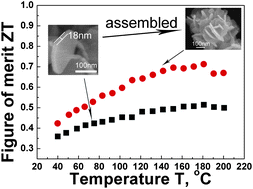Bi2Te3 nanoplates and nanoflowers: Synthesized by hydrothermal process and their enhanced thermoelectric properties†
Abstract
Bi2Te3 nanoplates with a thickness of 15–20 nm and self-assembled flower-like

* Corresponding authors
a
State Key Laboratory of Rare Earth Resource Utilization, Changchun Institute of Applied Chemistry, Changchun, P. R. China
E-mail:
songsy@ciac.jl.cn, hongjie@ciac.jl.cn
Fax: + 86 431-85698041
Tel: + 86 431-85262127
b School of Chemistry and Environmental Engineering, Changchun University of Science and Technology, Changchun, P. R. China
Bi2Te3 nanoplates with a thickness of 15–20 nm and self-assembled flower-like

 Please wait while we load your content...
Something went wrong. Try again?
Please wait while we load your content...
Something went wrong. Try again?
J. Fu, S. Song, X. Zhang, F. Cao, L. Zhou, X. Li and H. Zhang, CrystEngComm, 2012, 14, 2159 DOI: 10.1039/C2CE06348D
To request permission to reproduce material from this article, please go to the Copyright Clearance Center request page.
If you are an author contributing to an RSC publication, you do not need to request permission provided correct acknowledgement is given.
If you are the author of this article, you do not need to request permission to reproduce figures and diagrams provided correct acknowledgement is given. If you want to reproduce the whole article in a third-party publication (excluding your thesis/dissertation for which permission is not required) please go to the Copyright Clearance Center request page.
Read more about how to correctly acknowledge RSC content.
 Fetching data from CrossRef.
Fetching data from CrossRef.
This may take some time to load.
Loading related content
